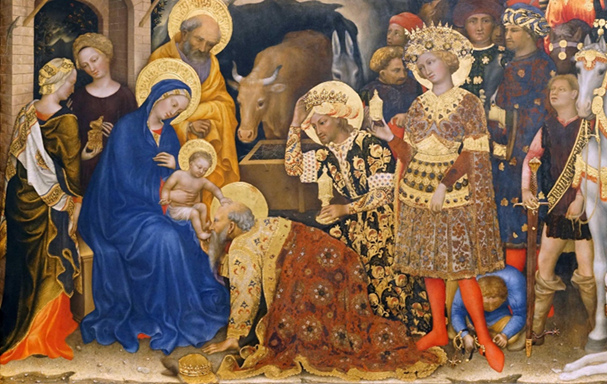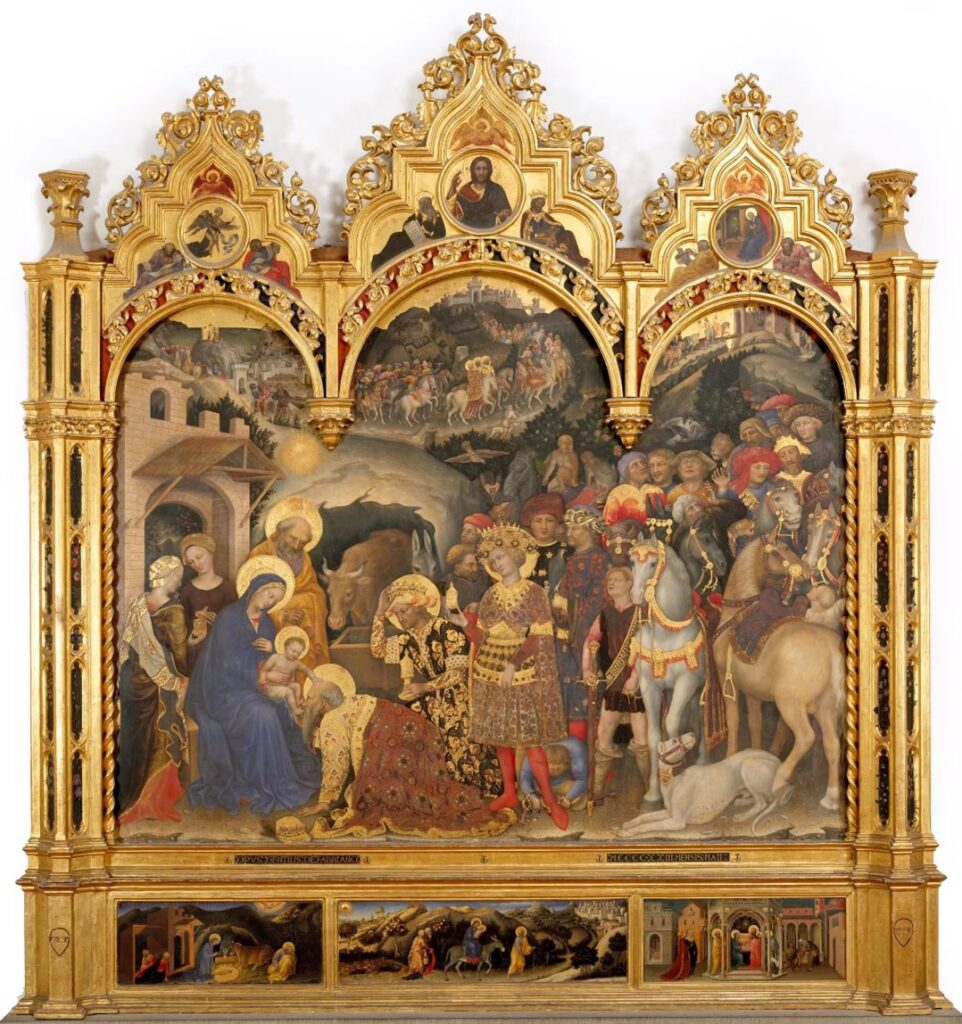Let’s Adore the Newborn Savior
The painting on the wall in the narthex of our church, Adoration of the Magi, is regarded as the finest work of Gentile da Fabriano. It was created for the Church of the Holy Trinity in Florence, Italy, in the year 1423. Presently it is being held in the famous Uffizi Gallery in Florence. I am very fortunate to have visited this gallery twice. In his painting, the artist created a dynamic visual narrative of the journey of the Magi to Bethlehem recounted in the Gospel of Matthew. The painting uses continuous narrative to show us the moment the Magi first see the star announcing Jesus’ birth, their journey to Jerusalem, and then subsequent arrival in Bethlehem where they meet the infant Jesus. In this reproduction, which is displayed on our church narthex wall, only the last story of the painting is fully visible.

Let’s look at some of the details of the Fabriano image. It seems that the Magi take turns kneeling before Jesus and presenting him with gifts of gold, frankincense, and myrrh. The oldest Magi, Melchior, is kissing Jesus’ foot as Jesus blesses him. The other two Magi, Caspar and Balthazar, prepare to do the same, holding their gifts aloft. All three Magi are elaborately dressed, and each one has a golden crown.
The halos around Mary and Joseph are brilliant gold, emphasizing their holiness. The halos also include what appears to be Arabic writing that is not visible in our reproduction. This, and the fact that multiple figures in the painting wear turbans, indicates someone of Middle Eastern descent.
Magi wear very rich garments: elaborate brocades, damasks, other silks, and velvets. Melchior wears a patterned garment of pearlescent white with golden accents, and above that, a mantle accented with gold and silver. Caspar wears a long tunic in black decorated with golden pomegranates. The pomegranate was a prominent Christian symbol of rebirth. Balthazar’s outfit is similarly elaborate. His abdomen is covered in golden designs that almost mimic peacock feathers. The peacock is a symbol of resurrection which dates back to antiquity.
One can be surprised that the artist placed an exotic menagerie into the riotous scene: two monkeys sit atop a camel, a lion eyeing two birds, and among the tightly packed group of men there is a leopard or possibly a cheetah. The horses are likely Arabian, and, along with the camel, are pointing at the eastern origin of the Magi.
All these elements of the painting express brilliantly and suggestively the main religious message of the Florentine painting: The Magi and other people present there, and even the animals – the entire splendor and wisdom of the world – arrive to give homage to the Newborn Jesus. They show their utmost respect and admiration to the One because He came to rescue all people from death, to open for them the way to salvation – that is the way to eternal life. Only He, and nobody else in the entire universe, is able to do this. So, it is obvious, that the wealth of the world is nothing in comparison with such a Newborn host who gives hope to the descendants of Adam and Eve, to mankind. The attitude of the Magi – searching diligently for the truth and persistently following what they discovered – reminds us of a merchant from Jesus’ parable who was “looking for fine pearls. When he found one of great value, he went away and sold everything he had and bought it.” (Mt 13:45-46)
On the Feast of Epiphany – the Revelation of the Savior to all people in the world – let’s join the Magi and others in our worship and praise of the Lord who came in poverty to teach us the real value of all things and the real value of our life.
Fr. Mark Jurzyk

